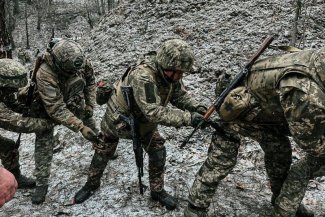Ukrainian forces step up operations on the battlefront. Day 1084 of the war

Ukrainian forces have carried out a series of counterattacks near Pokrovsk, regaining some positions southwest of the city and slowing the Russian advance. Conflicting reports have emerged from Toretsk. According to some sources, the last two settlements in the Toretsk agglomeration, Krymske and Druzhba, have fallen under Russian control. However, Ukrainian command has denied these claims, insisting that fighting is still ongoing in the urban area. Russian forces have made gradual progress in clearing the salient west of Kurakhove: they have reached the northern outskirts of the key settlement of Kostiantynopil, effectively placing the village in a pincer. Meanwhile, Russian troops have made further gains in Chasiv Yar, in areas to the north and south of this city as well as around bridgeheads on the right bank of the Zherebets River towards Lyman and on the right bank of the Oskil River north of Kupiansk.
On 6 February, Ukrainian forces launched an assault southeast of Sudzha, where, according to President Volodymyr Zelensky, they advanced 2.5 km deep into Russian positions. However, they failed to achieve a breakthrough and were largely pushed back to their previous positions in the following days. Meanwhile, Russian forces have made further advances in the northwestern section of the Ukrainian area in Kursk Oblast, reducing their distance to Sudzha to 9 km.
The increased activity of Ukrainian forces should be linked to US statements regarding efforts to end the conflict, particularly in the lead-up to the Munich Security Conference (14–16 February). Ukraine aims to demonstrate that its armed forces have retained significant capabilities and remain determined to continue their defensive operations. The counterattacks near Pokrovsk should also be seen as a direct consequence of General Mykhailo Drapatyi’s return to command of the Donbas forces (the Khortytsia operational-strategic group of troops). While the actions taken by the Ukrainian command can slow the Russian advance locally, Ukrainian forces currently lack the strength and resources needed to regain and sustain the initiative, even on a single sector of the battlefront.
![]()
On 11 February, Russia launched a massive missile attack on gas infrastructure in Poltava Oblast. According to Ukraine’s Air Force Command, it used 19 ballistic and cruise missiles. Following the attack, Naftohaz reported damage to local “production capacities.” The intensity of Russian drone attacks on energy and logistics infrastructure in oblasts directly behind the front lines has increased once again. Between the evening of 4 February and the morning of 11 February, Russia reportedly used a record 790 unmanned aerial vehicles; according to Ukraine, 449 were downed, while 322 were locationally lost. Russian forces also launched 32 missiles, two of which were reportedly shot down. The attacks targeted a number of cities, including Kharkiv (5 and 6 February), Zaporizhzhia (5 and 6 February), Mykolaiv (6 February), Sumy (8 and 9 February), Kyiv (8 and 10 February) and Odesa (10 February). As a result of these strikes, Ukrenerho imposed emergency power shutdowns in southern and eastern Ukraine on three occasions: on 6, 7 and 11 February.
![]()
On 5 February, a Ukrainian drone attack destroyed two fuel tanks at the Albashneft refinery in Krasnodar Krai, as confirmed by satellite images. According to official Ukrainian sources, drones also struck an airfield in Primorsko-Akhtarsk on the coast of the Sea of Azov on 5 February, an “area with important military facilities” in Rostov Oblast on 8 February and a refinery in Saratov Oblast on 11 February.
![]()
On 6 February, French Defence Minister Sébastien Lecornu announced that the first Mirage 2000 fighter jets had arrived in Ukraine. While he did not provide any details, earlier reports suggest that the Ukrainian Air Force has likely received three Mirage 2000-5F jets out of a total of ten to be delivered. The French donation is too small to significantly enhance the capabilities of the Ukrainian Air Force. Unlike the previously supplied F-16 fighter jets, which have been used in an air-to-air role, mainly to intercept cruise missiles, the Mirage 2000-5F will add to Ukraine’s fleet of aircraft designed for ground attack missions, as they have been adapted to carry Storm Shadow/SCALP cruise missiles.
Latvia has ordered Patria 6×6 wheeled armoured personnel carriers for Ukraine, with delivery scheduled for 2025, Defence Minister Andris Sprūds announced on 10 February. The vehicles will come from Latvian assembly plants, where they are being built using components supplied from Finland.
In an interview with British journalist Piers Morgan on 5 February, President Volodymyr Zelensky said that 40% of the weapons and military equipment used on the battlefront have been made in Ukraine, while 30% have been supplied by the United States. Two days later, Deputy Defence Minister Ivan Havryliuk addressed this issue, citing ministry data showing that 70% of equipment used on the battlefield comes from international assistance. However, Ukrainian officials have not commented on the reliance of the country’s defence industry on imported components and materials, particularly for mass-produced drones.
![]()
On 4 February, President Volodymyr Zelensky acknowledged that more than 45,000 Ukrainian soldiers had been killed in the war against Russia, with approximately 390,000 wounded. He added that Russian military losses amounted to around 350,000 killed and between 600,000 and 700,000 wounded; another 50,000–70,000 soldiers are considered missing.
On 5 February, another prisoner exchange took place under a 150-for-150 arrangement. Among those released were soldiers captured in Mariupol and Zaporizhzhia Oblast.
On 6 February, Ukraine’s Supreme Court ruled that the military service of a mobilised soldier begins on the day they are assigned to a unit rather than upon taking the oath. In a related criminal case, the court found a soldier guilty of refusing to follow an order to report to the second line of defence and participate in fortification work. The court rejected the defence lawyer’s argument that the accused had legal grounds to disobey the order as he had not yet taken the oath or undergone proper training.
On 8 February, President Zelensky announced that the defence ministry was preparing legislation to allow men aged 18 to 24 to sign up for contract service. He explained that this would be a “special contract” lasting one year and offering attractive pay.
![]()
Buildings used as military recruitment offices and police stations have become targets of terrorist attacks carried out by individuals working with Russian intelligence services. On 1 February, an explosion occurred near a military recruitment office in Rivne, killing one person – the bomber who was identified by police as a 21-year-old unemployed man from Zhytomyr Oblast; eight others were injured in the attack. The next day, a blast near a military recruitment office in Pavlohrad, Dnipropetrovsk Oblast, wounded one person; the Security Service of Ukraine (SBU) arrested three men aged 21 to 24 in connection with this incident. On 3 February, two 19-year-old men were apprehended in Rivne for planning a terrorist attack near the district police headquarters. On 5 February, an explosion near a military recruitment office in Kamianets-Podilskyi, Khmelnytskyi Oblast, killed one person and injured four others. Ukrainian police chief Ivan Vyhivskyi stressed that these bombings, orchestrated by Russian operatives, are aimed at destabilising the country and fuelling distrust towards Ukraine’s Security and Defence Forces by making contact with them a potential life-threatening risk. He also noted that Russian intelligence services have been targeting police officers by placing fake calls to the 112 emergency number and then attempting to kill them at the reported crime scenes. On 7 February, the Ukrainian Ground Forces Command stated that security measures at recruitment offices and military units had been strengthened due to the threat of terrorist attacks. This includes increased patrols, expanded surveillance systems and stricter access controls at military facilities.
On 5 February, the spokesperson for the State Border Guard Service, Andriy Demchenko, reported that since the beginning of the year, Russian sabotage and reconnaissance groups had attempted to cross into Ukraine twice in Sumy and Kharkiv oblasts, but border guards repelled both incursions. No such activity had been observed in Chernihiv Oblast.
![]()
On 7 February, President Zelensky, citing information from the Commander-in-Chief of the Armed Forces, General Oleksandr Syrskyi, said that North Korean soldiers had returned to Kursk Oblast, operating as part of a Russian group of forces numbering 60,000 personnel.
On 10 February, the government-run National Resistance Center reported that Russian forces had stepped up forced conscription in the occupied territories to compensate for their battlefield losses. In addition to Ukrainians living in those areas, this mobilisation includes migrant workers from Central Asia.






